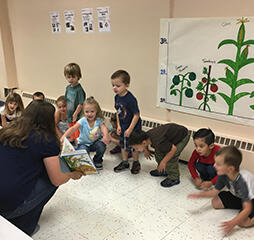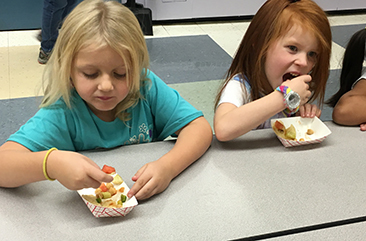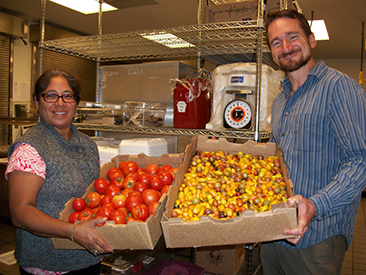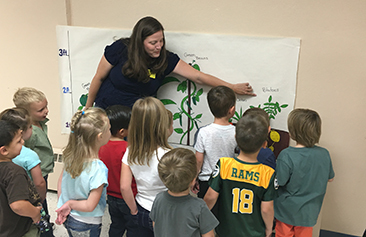
The Power Of Project Produce
Breaking through to kids using nutrition education
November 11, 2015
“Corn grows up, potatoes grow down, cucumbers vine around and around.” The preschoolers sit in a semi circle, eyes wide, enraptured by the veggie tale their teacher is reading aloud, at the same time squirming to experience the other events that the day has in store. With the help of a dedicated food service team, the children are making chickpea Pico de Gallo while learning about the vegetables they’re using, tasting them, and loving them.
It’s a Project Produce day at Spark! Discovery Preschool in Longmont, Colorado, which means it’s a day of learning, sharing, eating, and having fun.
If you’re a parent, guardian, teacher or lunch lady, you know that it’s not always easy convincing kids to eat their vegetables and fruits. USDA school food standards require a serving of fruit or vegetables on every school lunch tray. But what happens when students won’t eat it? Lunchroom education that includes samplings of fresh fruits and vegetables is a great way to expand kids’ palates and help ensure foods like broccoli and beets end up in their bellies, not the trash. Launched by Chef Ann Foundation and superfoods company Healthy Skoop in 2014, Project Produce helps schools purchase fresh produce to include in their nutrition education efforts, helping school kids across the country to learn to love fruits and veggies.
St. Vrain School District
St. Vrain Valley School District of Longmont, Colorado has embraced the power of Project Produce, receiving three $2,500 cash grants within the past year. “Thank you to whoever put this grant together,” comments Sarah Harter, School Wellness Coordinator. “It’s a manageable size, and it was a really easy application. Sometimes we spend so much time writing grants that it can deter us from applying, but Project Produce was simple and concise, and it gave us the opportunity to have meaningful experiences with the kids.”
- District Size – enrollment: 30,000
- Number of Schools in District: 46
- Project Produce Schools: Spark! Discovery Preschool, Flagstaff Academy, Old Columbine High School – Teen Parenting Program
- F/R percentage (free and reduced): 32%
- District ADP (average daily participation): 66%
Under the guidance of veteran Food Service Director Shelly Allen, St. Vrain has been working to improve their meal program since 2008. They’ve changed their menus to highlight quality ingredients, are using salad bars in the cafeteria to make fruit and veggies more readily available, and have grown a vibrant farm to school program, serving 900,000 pounds of Colorado produce just in the last year.
Dovetailing on this impressive progress, St. Vrain decided to focus their Project Produce funded nutrition education projects on schools they didn’t often get the chance to interact with: a preschool, a charter school, and in the coming year, a teen parenting program.
Spark! Discovery Preschool
Inspired by the children’s book Up, Down and Around, which explains how vegetables grow, Allen and Harter built an entire day around the story. One station was for reading the book, another station had a growing wall where the children could compare their heights to that of the vegetables in the story. Then of course, came the veggie sampling. On the menu was a healthy Chickpea Pico de Gallo a recipe that was easy enough for the kids to participate in, and tasty enough to please both kid and adult palates.


Spark! Discovery Preschool
Inspired by the children’s book Up, Down and Around, which explains how vegetables grow, Allen and Harter built an entire day around the story. One station was for reading the book, another station had a growing wall where the children could compare their heights to that of the vegetables in the story. Then of course, came the veggie sampling. On the menu was a healthy Chickpea Pico de Gallo a recipe that was easy enough for the kids to participate in, and tasty enough to please both kid and adult palates.
The recipe went home to all parents, who were amazed to see their children hungrily scooping up every last bite. The salsa now makes regular appearances on the school salad bar and it is undoubtedly one of the favorites “We can’t make enough!” Allen happily reports. “It’s always gone by the end of the day.”
Flagstaff Academy
With an older, middle school student population, the food service team decided to take a different approach – a series of events that highlight a featured fruit or veggie and the farmer who grew them. “The idea for it came out of a conversation with the school’s gardening teacher, who wanted to find ways to connect the salad bar to all students, even the ones who didn’t buy a lunch,” Harter explains. “She wanted them all to realize that the salad bar was an option for everyone, and she wanted them to take advantage of it.”
Partnering with neighboring Ollin Farms, the first event of the series was held this past September and the featured produce item was fresh from the farm, cherry tomatoes. “Yellow, purple, green and red - they brought us such an array of tomatoes, varieties that I’d never even seen before!” says Allen. The farmers, a dynamic husband/wife duo named Mark and Kena Guttridge, stayed to teach the kids about the different varieties and to answer the flurry of questions about their harvest.


Partnering with neighboring Ollin Farms, the first event of the series was held this past September and the featured produce item was fresh from the farm, cherry tomatoes. “Yellow, purple, green and red - they brought us such an array of tomatoes, varieties that I’d never even seen before!” says Allen. The farmers, a dynamic husband/wife duo named Mark and Kena Guttridge, stayed to teach the kids about the different varieties and to answer the flurry of questions about their harvest.
Allen and her team were grateful for the opportunity to reach all students, especially the picky eaters. Being able to sit down with the kids and talk about why they don’t like certain items is so important to breaking through their resistance. “I don’t eat anything red…” one tomato naysayer commented. Why? “I don’t know I just don’t like red.” “Well,” Allen begins, “this red tastes really good – taste this red.” Sure enough, the red of a local, just picked tomato was tasty enough to go back for a second bite, and a third.
Reflecting on the success of the day, Allen noted, “When people make the connection about where their food is coming from, they really enjoy it. I mean, we serve tomatoes every day, but it was nothing like that day.” The salad bar was completely cleaned out and even some of the less adventurous students were convinced to try “no thank you bites” and “adventure bites”. Upon biting into an especially ripe cherry tomato that exploded with juice, one student exclaimed “these are like little vegetable bombs!” Having fun with healthy food is the first step towards embracing it.
The star of the next event, taking place later this month, is turnips. “I’m a bit nervous about it, but kids are more adventurous than we give them credit for,” Harter reasons. “It will be a good benchmark to see how adventurous we can get with the next two events!”

A Little Education Makes All the Difference
Giving food service teams the chance to take on the role of educators makes a real difference in how kids interact with fruits and vegetables at school. “Most of the time we don’t have a whole lot of interaction with the classroom. It was great to create those relationships with the teachers, and for the parent volunteers to see us in that light. They started to see food service as an extension to education,” Allen reflects. That is what Project Produce is all about – giving schools the chance to turn the lunchroom into a place of learning, just like every other room in the school.

A Little Education Makes All the Difference
Giving food service teams the chance to take on the role of educators makes a real difference in how kids interact with fruits and vegetables at school. “Most of the time we don’t have a whole lot of interaction with the classroom. It was great to create those relationships with the teachers, and for the parent volunteers to see us in that light. They started to see food service as an extension to education,” Allen reflects. That is what Project Produce is all about – giving schools the chance to turn the lunchroom into a place of learning, just like every other room in the school.
Preparing for their teen-parenting event now, both Harter and Allen are excited by the possibility of reaching these young adults, and their kids, with healthy lifestyle choices. The workshop will break down the basics of grocery shopping on a budget and how new moms and dads can prepare adult meals, and then take the same food components and make a nourishing meal for their toddlers or infants. “Our plan is to break down the barrier between adult meals and kid meals by using all the same ingredients.”
Certainly, the St. Vrain team has done a fantastic job of breaking down barriers through these fun and innovative programs.

Some Parting Advice
Getting the school on board with the food service team’s plan early is crucial to a successful event. “It makes it so much easier to implement when the school principal and teachers are excited about it, and help recruit parent volunteers” comments Allen.
“And think outside the box!” Harter chimes in. “This grant gives you the chance to be creative, so be intentional about your project plan. Think through how you can find small, simple ways to interact and connect with that child in meaningful ways.”

Some Parting Advice
Getting the school on board with the food service team’s plan early is crucial to a successful event. “It makes it so much easier to implement when the school principal and teachers are excited about it, and help recruit parent volunteers” comments Allen.
“And think outside the box!” Harter chimes in. “This grant gives you the chance to be creative, so be intentional about your project plan. Think through how you can find small, simple ways to interact and connect with that child in meaningful ways.”
Allen’s last piece of advice: “Have fun with it – it’s $2,500 to go have fun and teach kids.” When asked if they’d apply for another Project Produce grant in the future, the answer was a resounding, YES!
Learn more about how you can apply for a Project Produce grant here. We look forward to reviewing your application!







